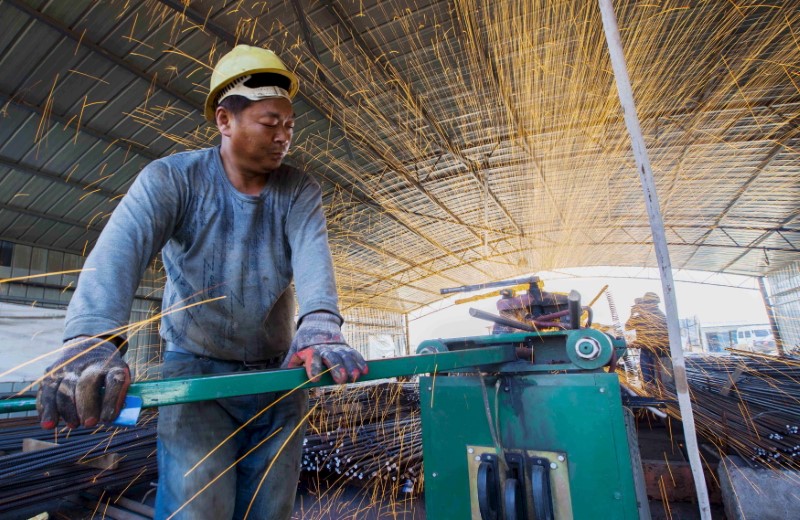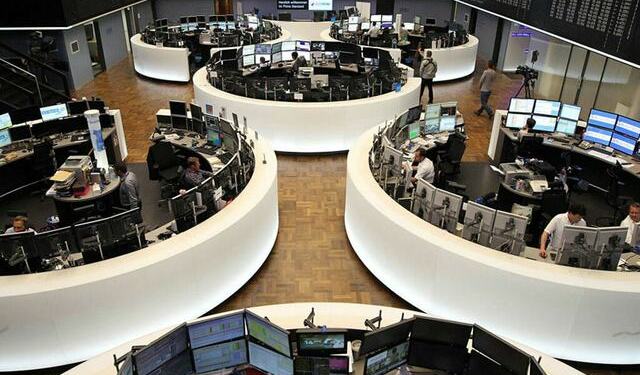 © Reuters. Labourer cuts steel bars at a railway bridge construction site in Lianyungang
© Reuters. Labourer cuts steel bars at a railway bridge construction site in LianyungangBEIJING (Reuters) – China’s industrial output grew much faster than expected at the start of the year, suggesting the economy may be picking up momentum even as U.S. President Donald Trump readies hefty tariffs against one its most strategic growth drivers — technology.
Tariffs on tech exports could potentially hit the fastest growing segment of China’s industrial sector, an area that the country’s leaders have been keen to promote as they push for “higher quality” economic growth.
Trump is seeking to impose tariffs on up to $60 billion of Chinese imports in the very near future and will target the technology and telecommunications sectors, Reuters reported on Tuesday.
(For a graphic on ‘Trends in China’s industrial output, investment and retail sales’ click http://tmsnrt.rs/2iO9Q6a)
The latest U.S. trade threat, which follows the imposition of tariffs on steel and aluminum last week, overshadowed unexpectedly robust Chinese industrial and investment data for the first two months of the year.
“There is a good possibility that Trump will do a lot more against China…The trade situation is obviously a rising risk and a relatively new challenge for China,” said economist Kevin Lai at Daiwa Capital Markets in Hong Kong.
Industrial output in January-February rose 7.2 percent from the same period a year earlier, the National Bureau of Statistics said on Wednesday, surpassing analysts’ estimates for a rise of 6.1 percent and picking up sharply from 6.2 percent in December.
Analysts had expected a slight stumble due to a crackdown on heavily polluting industries, but the data showed China’s steel output rose to its highest in months as mills prepared for a seasonal pick-up in construction in spring.
Coal and power output were also up sharply, possibly reflecting a spell of bitterly cold weather.
Reflecting China’s growing focus on the production of higher-value goods, the output of computers, telecommunications equipment and other electronics rose 12.1 percent on year, extending a long period of double-digit growth.
Output of industrial robots rose around 25 percent.
However, data from China early in the year is typically treated with caution due to distortions caused by the timing of the week-long Lunar New Year celebrations, which fell in late January 2017 but started in mid-February this year.
As such, a clearer picture of China’s economic health may not emerge until first-quarter data is released in April.
Many economists expect China’s growth to moderate this year, weighed down by a cooling property market and the government’s clampdown on riskier lending practices, which is pushing up corporate borrowing costs.
But most readings available so far, ranging from output to property investment to business surveys, suggest China’s growth has picked up so far this year, keeping a synchronized global recovery on track.
Upbeat trade data last week had tipped a stronger industrial showing, with exports unexpectedly surging at the fastest pace in three years in February even as trade relations with the United States rapidly deteriorate.
China runs a $375 billion trade surplus with the United States and when President Xi Jinping’s top economic adviser visited Washington recently, the administration pressed him to come up with a way of reducing that number.
“While risks of escalation in US-China trade tensions exist, we expect China to remain relatively restrained in its response and, as a result, overall economic damage to stay contained,” Louis Kuijs, head of Asia economics at Oxford Economics said in a note.
China’s electronics and tech exports account for 43 percent of its total exports to the United States. Economists at UBS estimate that a 10 percent tariff would cut 0.3-0.4 percentage points from China’s GDP growth and possibly knock other Asian countries which are closely tied into its supply chains.
STRONG INVESTMENT READINGS
An unexpected rebound in investment also suggested a more resilient outlook for the economy, even if U.S. trade frictions start to drag.
Fixed-asset investment growth accelerated to 7.9 percent in January-February. Analysts had predicted it would cool to 7.0 percent from a 7.2 percent pace in all of 2017.
Private sector investment rose 8.1 percent, compared with an increase of 6.0 percent in 2017. Private investment accounts for about 60 percent of overall investment in China.
Investments by state firms rose 9.2 percent over the period, though the gap between public and private sector investment narrowed over last year.
Confounding expectations for a slowdown, real estate investment rose 9.9 percent, the fastest pace in three years, though property sales softened in the face of government measures to cool heated housing prices.[nL3N1QU1UK]
While infrastructure remains a main engine behind China’s investment growth, economists at ING note investment in hi-tech manufacturing has also expanded rapidly, and was up 17 percent last year, further highlighting the sector’s vulnerability to punitive U.S. trade measures.
Infrastructure spending rose 16.1 percent over Jan-Feb, slower than 19 percent growth last year, as some local governments hold back on large building projects in the face of Beijing’s crackdown on rising debt.
Retail sales also regained some momentum, rising 9.7 percent, just shy of expectations but up from 9.4 percent in December. Auto sales were particularly strong, especially electrics and hybrids, again reflecting Beijing’s tech push.
Premier Li Keqiang said last week China aims to expand its economy by around 6.5 percent this year, the same target that it handily beat in 2017 thanks in part to massive government infrastructure spending and record bank lending.
But comments by top officials at China’s parliament in the past week suggested that Beijing will be more cautious about spending this year while it focuses on reducing financial risks.
After years of heavy pump-priming by Beijing, markets worry that less generous stimulus could slow the pace of expansion not only in China but globally. China is already believed to be contributing about a third of total world growth.
“Internally (in China), there’s a lack of stimulus; monetary policy is getting a little bit tighter,” Daiwa’s Lai said.
“The leaders are probably more tolerant of lower growth in general.”
Source: Investing.com



























